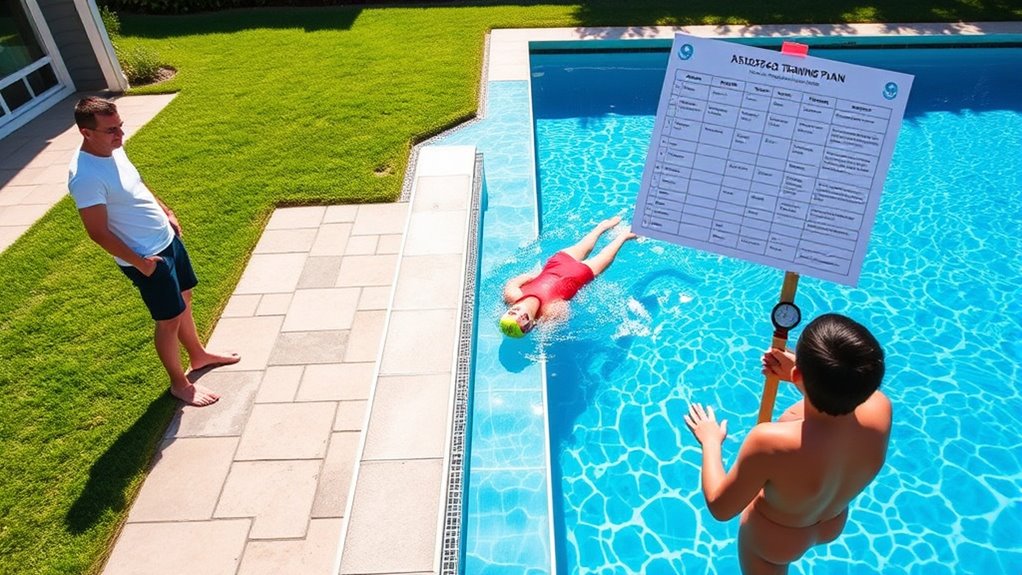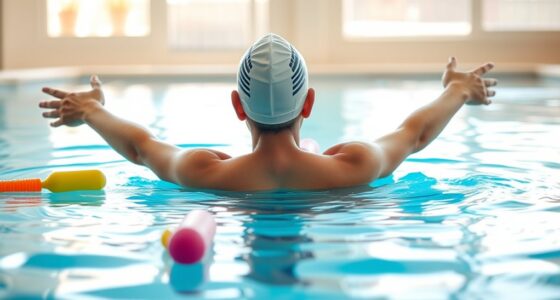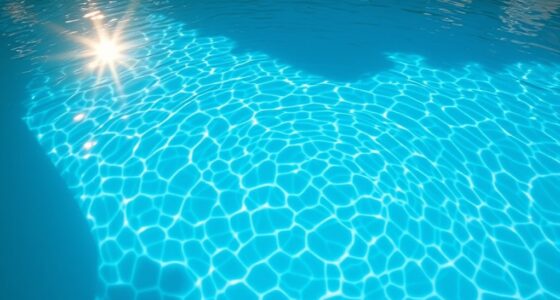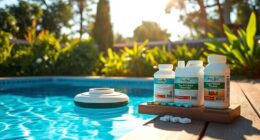To create an effective swim training plan for your 25-yard backyard pool, focus on space-efficient drills, safety, and gradual progress. Set realistic goals for endurance, technique, and strength based on your schedule. Incorporate interval training, core exercises, and targeted stroke drills to maximize limited space. Track your progress consistently and adjust as needed. Keep your workouts short but focused, and if you stick with it, you’ll discover more ways to make the most of your small pool.
Key Takeaways
- Measure your pool accurately to tailor drills and set realistic distance goals.
- Focus on technique and endurance with interval workouts and specific drills suited for limited space.
- Incorporate strength, flexibility, and core exercises to enhance overall swim performance safely.
- Use pool markings or tiles to track progress and adjust training intensity accordingly.
- Schedule varied sessions—endurance, technique, recovery—to maintain motivation and prevent overtraining.
Assessing Your Space and Setting Realistic Goals
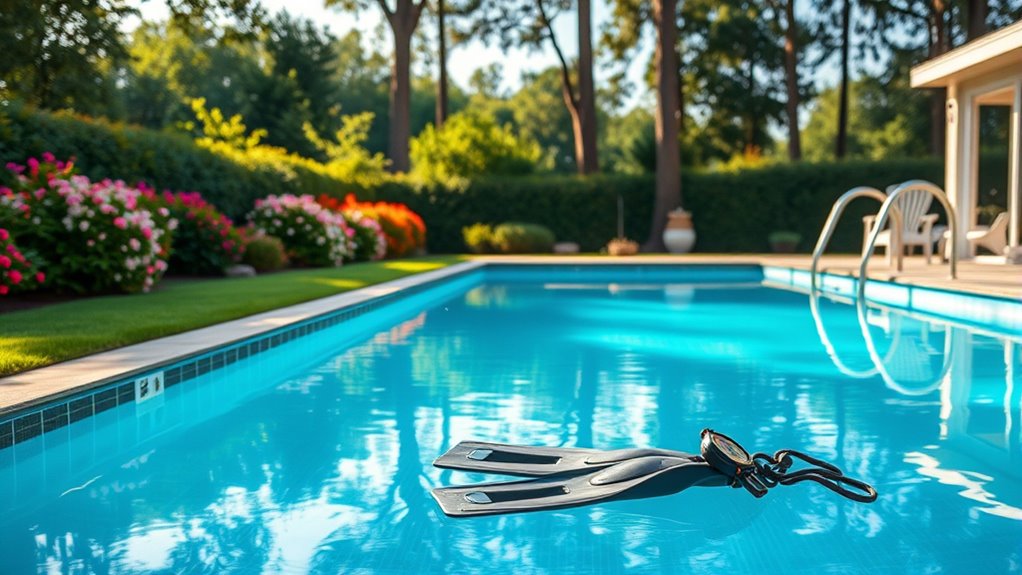
Before diving into your swim training plan, understanding your available space and setting achievable goals is essential. Measure your backyard pool’s size accurately, noting depth and length, so you know what’s possible. Consider how often you can swim and how long each session will last, aligning these with your fitness level. Be realistic about what you can accomplish in a small pool; don’t set goals that are too ambitious, like full-distance swims if space is limited. Focus on incremental progress, such as improving stroke technique or increasing endurance in short distances. Clear, achievable goals keep you motivated and help you track your progress. Adjust your plans as needed based on your space and how your body responds to training. Incorporating appropriate training techniques can also enhance your progress within your available space.
Essential Equipment for Small-Pool Training
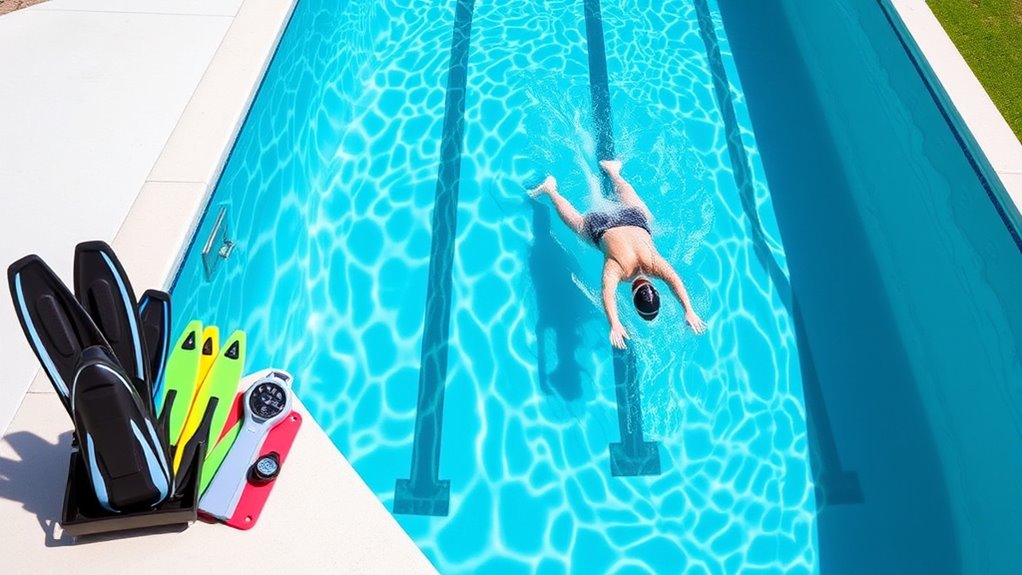
To make the most of your small pool, you’ll need some compact training devices that fit comfortably in limited space. Safety and maintenance are also vital to keep your equipment in good shape and prevent accidents. Let’s explore the essential gear that will help you train effectively and safely. Additionally, understanding divorce statistics can help you prepare mentally for any unexpected challenges during your training journey.
Compact Training Devices
Have you ever struggled to maintain proper technique or build endurance in a small pool? Compact training devices can make a big difference. These tools help you maximize your workout without needing extra space or equipment. They are designed to fit in limited areas, allowing you to focus on specific skills and improve form. With the right devices, you can simulate resistance, target stroke mechanics, and track progress effectively. These tools are portable, easy to set up, and versatile, making your training more efficient. They also help you stay motivated by providing measurable goals and immediate feedback. Incorporating these devices into your routine ensures you get the most from your small pool, turning limited space into a powerful training zone. Airless paint sprayers offer a variety of accessories and tips that can be adapted to your swim training needs.
Safety and Maintenance
Using training devices in a small pool can boost your performance, but safety and proper maintenance are vital to prevent accidents and guarantee long-lasting equipment. Always inspect your gear before each session, checking for tears, corrosion, or damage. Keep the pool area clean and dry to avoid slips. Store equipment in a cool, dry place away from sunlight. Regularly clean devices with mild soap and water. Proper color accuracy in your training tools can help simulate real-world conditions more effectively. Use the following chart to help you stay organized:
| Equipment | Maintenance Tips | Safety Precautions |
|---|---|---|
| Kickboards | Rinse after use; check for cracks | Avoid sharp edges |
| Pull Buoys | Store upright; clean regularly | Keep away from children |
| Hand Paddles | Inspect for tears; dry thoroughly | Use correct size to prevent strain |
| Swim Snorkels | Rinse after use; check valve integrity | Avoid improper use |
| Pool Cover | Clean debris; tighten straps | Remove before swimming |
Designing a Weekly Workout Routine
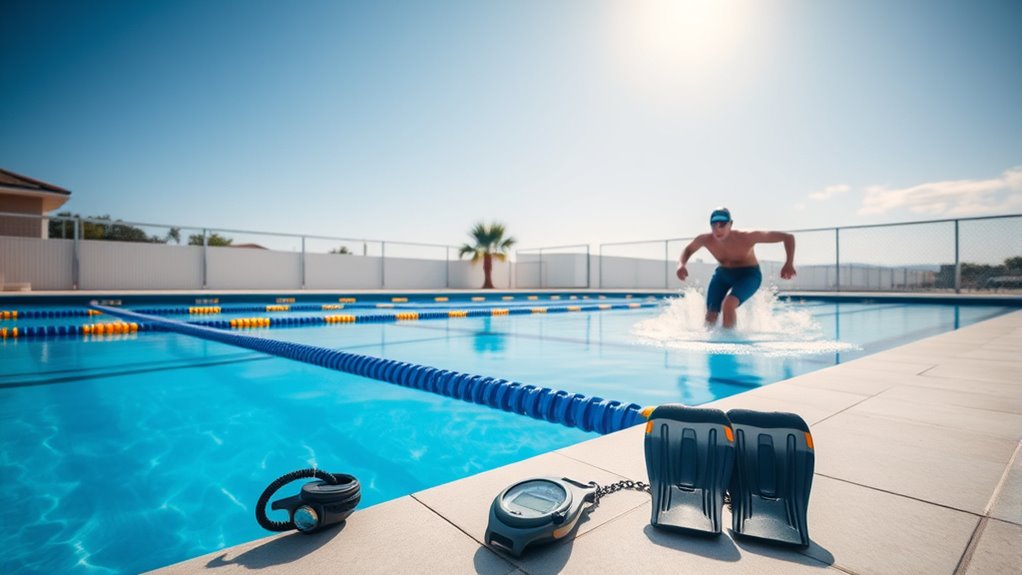
Creating a balanced weekly swim training routine requires careful planning to guarantee you build endurance, improve technique, and allow for proper recovery. Start by dividing your week into focused sessions that target different goals. For example:
- Incorporate endurance swims to gradually increase your stamina.
- Schedule technique drills to refine your form and efficiency.
- Include rest days or easy swims to let your body recover.
- Vary workout intensity to prevent plateaus and reduce injury risk.
- Incorporate training methodologies that align with your skill level and goals to maximize effectiveness.
Technique Drills for Limited Space

When space is limited, focusing on streamlined kick drills helps conserve energy and maintain efficiency. Concentrate on arm movement to maximize propulsion without needing a large pool area. Pay attention to your body position, as small adjustments can make a big difference in your overall technique. Incorporating mindfulness practices can further enhance your awareness and control during training sessions.
Streamlined Kick Drills
Have you ever struggled to improve your kick technique in tight spaces? Streamlined kick drills are perfect for refining your form without needing a large pool. These drills focus on maintaining a sleek, hydrodynamic position while kicking efficiently. You’ll emphasize a tight core, pointed toes, and smooth, steady movements. To help visualize, here are some key elements:
- Keeping your body aligned in a straight line from head to toes
- Minimizing excessive leg movement and unnecessary splashing
- Focusing on small, controlled kicks from your hips
- Maintaining a consistent rhythm to conserve energy
- Practicing proper technique ensures your kicks are both effective and sustainable.
Arm Movement Focus
Focusing on arm movement is essential for maximizing efficiency in limited space. Since you can’t rely on long strokes or extensive momentum, precise arm action becomes critical. Concentrate on high-elbow catches and early arm recovery to maintain a steady rhythm. Use drills like fingertip drag or single-arm swims to refine your technique without needing a large pool area. Keep your hands relaxed and ensure your arms move smoothly through each phase of the stroke. Focus on creating a strong pull that engages your back and shoulder muscles, maximizing propulsion with minimal movement. By emphasizing controlled, deliberate arm actions, you’ll develop better muscle memory and improve your overall stroke efficiency, even in a confined space. Incorporating technique drills designed for limited areas helps reinforce proper movement patterns and builds confidence in your swimming form.
Body Position Tips
Maximizing your body position is essential in limited space, as it directly impacts your efficiency and speed. To stay streamlined, focus on keeping your body flat and aligned, minimizing drag. Engage your core to maintain a horizontal posture, which helps reduce resistance. Remember to keep your head relaxed and in line with your spine, avoiding unnecessary movement. Incorporate these drills to improve your body position:
- Practice floating on your back, focusing on keeping your hips high.
- Use a kickboard to drill body alignment without arm movement.
- Perform streamline glides after each push-off for better posture.
- Focus on slow, controlled breathing to prevent body sagging.
- Understanding fandom’s past, present, and future can help you develop a more nuanced approach to your training and motivation.
These tips help you stay efficient even in confined spaces, maximizing your momentum with every stroke.
Building Endurance With Interval Training

Building endurance with interval training involves alternating high-intensity efforts with recovery periods, allowing you to push your limits without overexerting yourself. By combining short bursts of fast swimming with slower recovery laps, you improve cardiovascular capacity and stamina efficiently. To maximize results, vary your intervals based on your fitness level and goals. Here’s a simple example: Evidence‑based techniques can guide you in designing effective workouts that promote sustainable progress.
| Intensity Level | Duration |
|---|---|
| High Effort | 30 seconds to 1 minute |
| Recovery | 1 to 2 minutes |
| Number of Sets | 4 to 8 repetitions |
Incorporating Strength and Flexibility Exercises
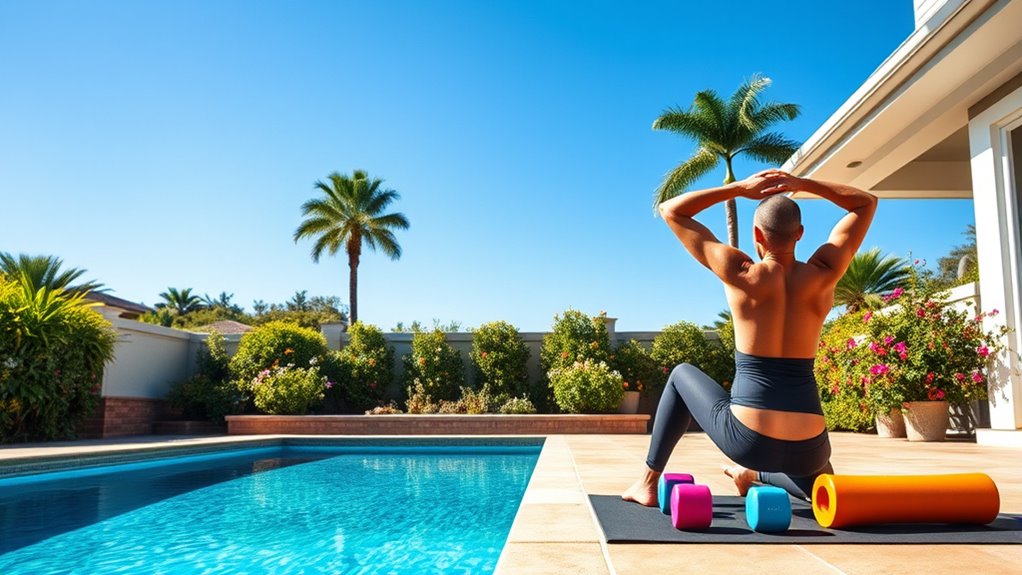
Incorporating strength and flexibility exercises into your swim training enhances overall performance and helps prevent injuries. Building muscle strength improves your power and endurance in the water, while increased flexibility allows for greater range of motion and smoother strokes. To get started, focus on exercises that target core muscles, shoulders, and hips, which are essential for efficient swimming. Consider adding these to your routine:
- Planks and side planks to strengthen your core
- Shoulder rolls and arm circles to improve mobility
- Hip bridges and leg lifts for leg strength and stability
- Dynamic stretches like arm swings and leg swings for flexibility
Tracking Progress and Staying Motivated
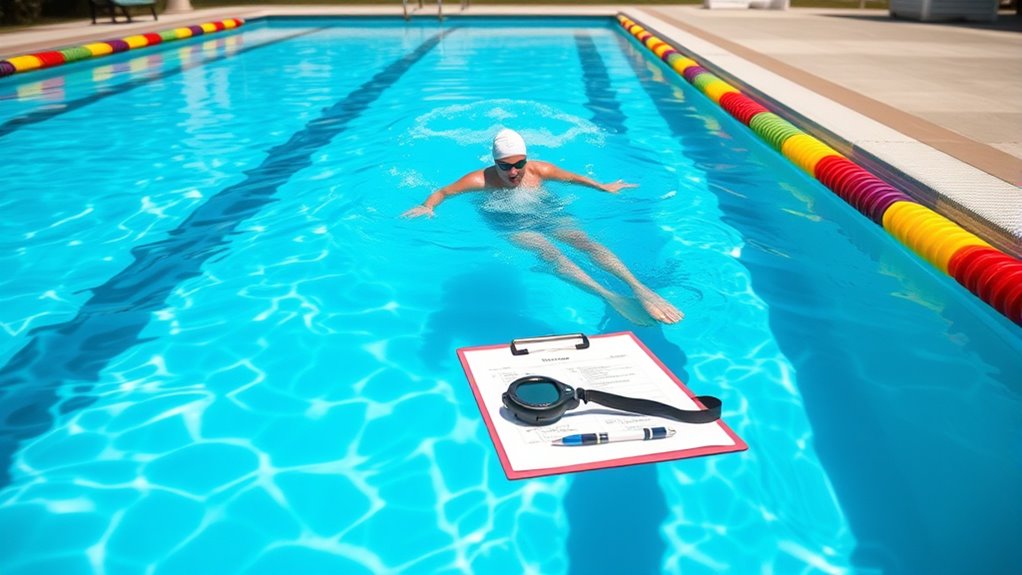
To stay motivated and track your progress effectively, it’s important to set clear, measurable goals and regularly review your achievements. Start by defining specific targets, like completing a certain number of laps or improving your time. Keep a training journal or use a digital app to log each session, noting details like distance, time, and how you felt. Celebrating small milestones boosts your confidence and keeps you engaged. Periodically assess your progress to identify areas for improvement and adjust your plan accordingly. Stay accountable by sharing your goals with a friend or joining online communities. Remember, consistency is key, so keep reviewing your progress and celebrate your wins to stay motivated on your swim training journey.
Tips for Safe and Effective Training in a Small Pool
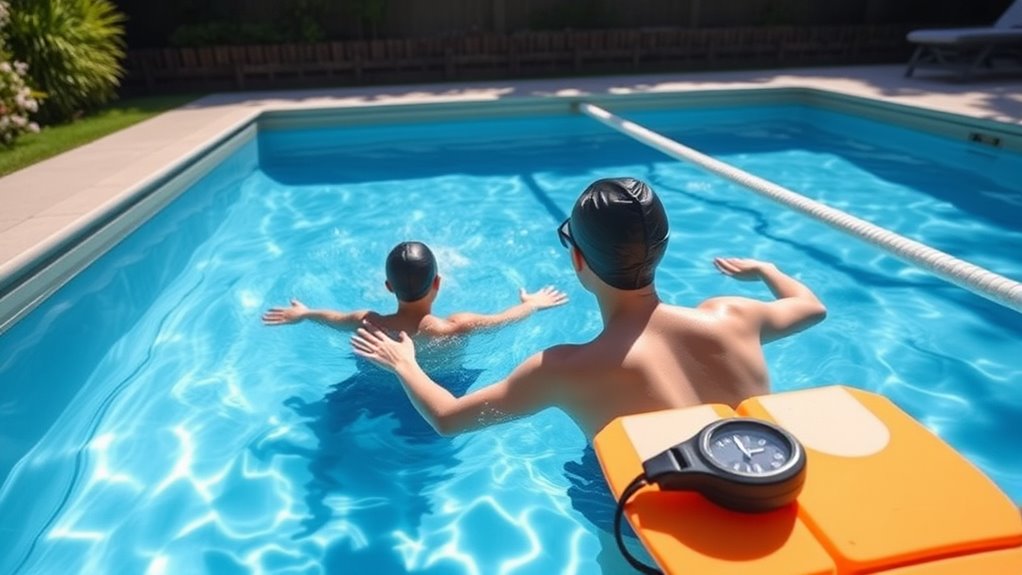
Practicing in a small pool can be highly effective if you prioritize safety and focus on targeted techniques. To stay safe, always avoid overexertion and monitor your energy levels. Use proper form to prevent injuries and stay mindful of your surroundings. Incorporate drills that maximize space without risking collision or fatigue. Keep your training sessions shorter but consistent to build endurance gradually.
- Wear appropriate swim gear, like goggles and a swim cap, to stay comfortable and focused.
- Use pool markings or tiles to measure distances and track progress accurately.
- Stick to a planned routine to avoid overdoing it in limited space.
- Always have a buddy or spotter nearby if possible, especially during intense drills or new techniques.
Frequently Asked Questions
How Can I Simulate Open Water Conditions in a Small Backyard Pool?
You can simulate open water conditions in your small backyard pool by creating waves with a paddleboard or floating device, mimicking current and turbulence. Practice sighting techniques by periodically lifting your head to focus on a distant marker, and vary your strokes to simulate different open water scenarios. Use waterproof headphones or sound systems to introduce ambient sounds, helping you adapt to the sensory environment of open water swimming.
What Are the Best Ways to Prevent Injuries in a Limited Space?
To prevent injuries in a limited space, you should prioritize proper warm-ups and cool-downs to prepare your muscles. Always use correct technique to avoid strain and overuse injuries. Keep the area clear of obstacles, and consider installing padded flooring or mats for extra cushioning. Stay within your skill level, listen to your body, and don’t push through pain. Regularly inspect your equipment to guarantee safety and reduce injury risks.
How Do I Balance Swim Training With Pool Maintenance Tasks?
You should schedule pool maintenance during your rest days or after workouts to avoid disrupting your training. Keep maintenance tasks quick and efficient, like skimming debris or checking chemical levels, so your swim sessions remain consistent. Use a routine checklist to stay organized and guarantee tasks don’t pile up. By balancing both, you maintain a clean pool and keep your training on track without feeling overwhelmed.
Can Small Pools Support Advanced Swim Training Programs?
Think of your small pool as a compact training gym—yes, it can support advanced swim programs, but with some adjustments. You’ll need to focus on maximizing space with interval training, drills, and resistance exercises. Keep in mind, the limited length means you’ll rely more on technique and stamina building in place of long-distance swims. Proper planning helps you turn even a tiny pool into a powerhouse for advanced training.
What Are Effective Mental Strategies for Motivation in Small Pool Workouts?
To stay motivated during small pool workouts, set clear, achievable goals to track your progress. Visualize your success and focus on improvements, which boost your confidence. Keep your workouts varied to prevent boredom and maintain excitement. Use positive self-talk to push through tough moments, and reward yourself for milestones. Remember, your commitment and mindset are key to staying motivated, even in limited space.
Conclusion
With the right plan, training in a small pool becomes as manageable as steering a well-worn path. Stay consistent, adapt your routines as needed, and celebrate your progress along the way. Remember, every splash and stroke builds toward your goals, making your small backyard pool feel like your personal oasis. Keep focused, stay motivated, and you’ll see improvements that make your efforts worthwhile—turning limited space into unlimited potential.
